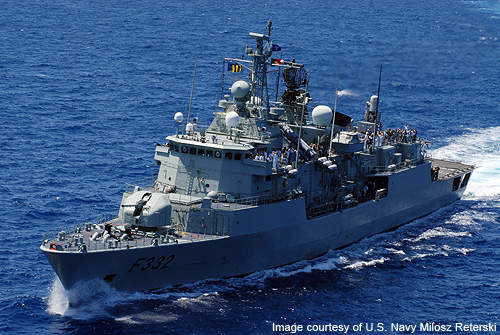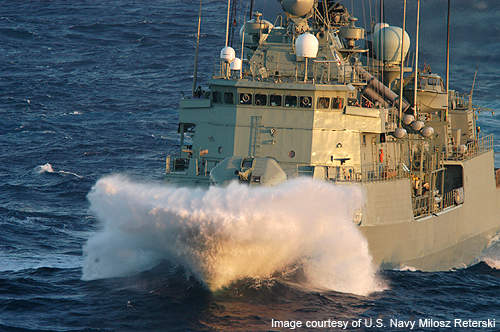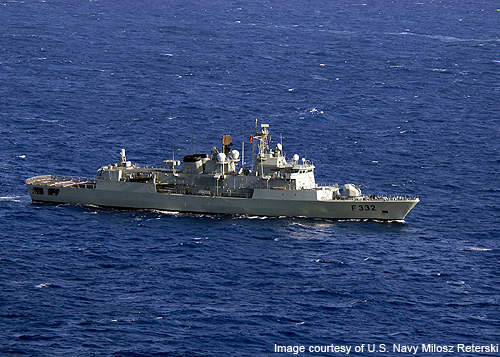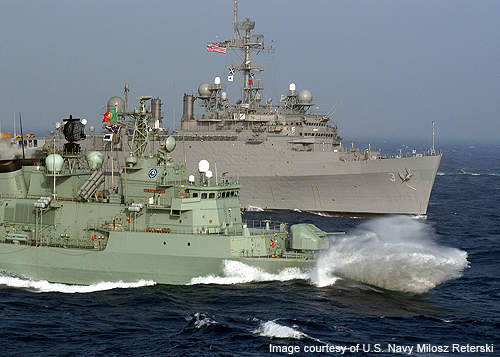The Vasco da Gama Class frigates are in service with the Portuguese Navy. Three frigates were built in Kiel by Blohm + Voss and HDW shipyards between 1989 and 1991.
Portuguese Navy requested the purchase of three new frigates in 1980 and construction was authorised by the Portuguese Government in 1985.
The shipbuilding contract for the first frigate was awarded in November 1986.
The keel for the first ship in the class, Vasco da Gama (F 330), was laid down at Blohm + Voss’ shipyard in February 1989.
The frigate was launched in June 1989 and commissioned in November 1990. The remaining frigates were built at HDW shipyard.
Álvares Cabral (F 331) was laid in June 1989, launched in May 1990 and commissioned in January 1991. The last ship in the class, Corte Real (F 332), was laid in October 1989 and launched in May 1990. It was commissioned into the Portuguese Navy in November 1991.
Vasco da Gama design and features
Based on the MEKO 200 PN design, the ships were built using modular construction techniques. Vasco da Gama Class frigates are the first ships in the Portuguese Navy to be equipped with surface-to-air and surface-to-surface missiles. The frigates incorporate fin stabilisers and a NAUTOS 2 propulsion control system.
The frigate has an overall length of 115.9m, a beam of 14.8m and a maximum draft of 5.9m. The full load displacement of the ship is 3,200t.
The ship can complement a crew of 182 including 23 officers, 44 petty officers and 115 ratings.
Command and control systems onboard
Vasco da Gama Class is equipped with the Signaal Tactical Command and Control System (STACOS). The system gathers the data from primary and secondary sensors to present the tactical air, surface and subsurface pictures after compilation. Other major functions include threat prioritisation, threat evaluation and weapon assignment.
Vasco da Gama missiles
The frigate is fitted with two Mk 141 quad launchers for firing eight RGM-84 Harpoon anti-ship missiles. The MK 21 guided missile launching system onboard can launch eight RIM-7 Sea Sparrow surface-to-air missiles. The Sea Sparrow carries a 40.5kg warhead for a maximum range of 19km.
Naval guns equipped onboard
The main gun fitted forward is a Mod68 CADAM 100mm dual purpose gun. A 20mm Mk 15 Phalanx Gatling CIWS (close-in weapon system) fitted on the aft deck can provide close-point defence against incoming missiles and artillery fire. It can fire 3,000 to 4,500 armour-piercing tungsten penetrator rounds to an effective range of 3.6km.
Torpedoes
The anti-submarine warfare (ASW) capability is provided by two 324mm Mk32 Mod 5 torpedo tubes in triple mountings. Each torpedo tube can launch a lightweight torpedo such as the Mk 44 or the Mk 46.
Sensors / radars
The sensor suite consists of type 1007 navigation radar, Thales DA08 early warning radar operating in D band, Thales MW08 3D air / surface search radar operating in F band, General Dynamics Mk 90 Phalanx fire control radar and two Thales STIR 180 fire-control radars. The frigate also incorporates SQS-510 hull mounted sonars.
Aircraft landing capabilities
The aft helicopter deck of the frigate accommodates a single Super Lynx Mk.95 helicopter.
The hangar facilities are provided for two helicopters.
Countermeasure equipment aboard the Vasco da Gama includes APECS II/AR-700 interceptor / jammer suite, Mk 36 Mod 1 SRBOC (super rapid blooming offboard chaff) decoy system and SLQ-25 Nixie towed acoustic torpedo decoy system.
Two six-round MK 137 SRBOC rocket launchers can fire chaff or infrared decoys to deceive incoming anti-ship missiles.
Propulsion and engines
The Vasco da Gama Class is powered by a CODOG (combined diesel or gas) propulsion system integrating two 8.14MW MTU 20V 956 TB92 diesel engines and two 38MW General Electric LM2500 gas turbines. Four diesel gen sets onboard generate an electric power output of 2,480kW. The propulsion system provides a maximum speed of 32kt and a range of 4,600nmi at 18kt speed.
The Global Naval Surface Combatants and Warfare Systems Market 2011-2021
This project forms part of our recent analysis and forecasts of the global naval surface combatants and warfare systems market available from our business information platform Strategic Defence Intelligence. For more information click here or contact us: EMEA: +44 20 7936 6783; Americas: +1 415 439 4914; Asia Pacific: +61 2 9947 9709 or via email.











